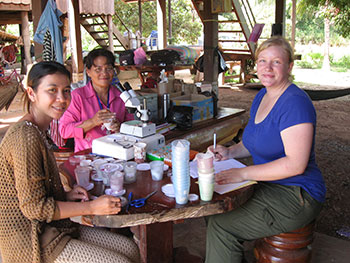"I feel like I come away from each day of the (Annual) Meeting having learned something new." - Brandy St. Laurent, PhD
A postdoctoral fellow at the NIAID Laboratory of Malaria and Vector Research. St. Laurent is a mosquito ecologist working with ASTMH Councilor Rick Fairhurst, MD, PhD, where she characterizes the vectors responsible for the transmission of artemisinin-resistant malaria in Cambodia. The lab side of that work was recently published in Nature Communications. Brandy also spends several months a year in Cambodia collecting mosquitoes. She is also a member of ACME and was recently awarded a Gates Grand Challenges Explorations grant to explore the use of cow-baited tents as a malaria control and monitoring tool. 
(Brandy St. Laurent, pictured right, processes mosquito collections with head entomologist Men Sary, center, and field and data assistant Kolthida Oy, left, in Cambodia.)
Congratulations on your Gates Grand Challenges and Explorations award and recent publication. It’s impressive to see this kind of momentum so early in your professional life. What or who has helped you and offered you guidance?
I am really lucky to have been exposed to a lot of great infectious disease biologists who were encouraging in my graduate and postdoctoral training. During my graduate work at Notre Dame, there were people working on several different tropical diseases, which provided a glimpse into how to approach studying a variety of transmission systems. International experiences have also been a great guide for my work. My graduate advisor, ASTMH member Frank Collins, PhD, enabled me to do mosquito field work in Indonesia, Zambia, and a bit in Kenya. Now I spend a lot of time in Cambodia and I am learning about the parasite side of transmission in a very applied clinical context. Working alongside villagers who deal with malaria every day, public health workers and local entomologists really helps to inform our research goals.
When did you first become aware of ASTMH?
My first ASTMH meeting was toward the end of my PhD work, but I was aware of ASTMH from early in my graduate career because it is the one meeting that everyone goes to every year. I didn’t realize how huge the society and meeting was until I went that first time in 2011 and I have been there every year since then.
If a peer asked you why you belong to ASTMH, what would you say?
As someone really focused on internationally collaborative malaria work, TropMed is one of the only meetings where I can catch up with former and current collaborators from all over the world and meet new ones. I also really appreciate the mix of scientists working on all different aspects of transmission. I feel like I come away from each day of the meeting having learned something new. I also have several close friends from my field work that I see once a year at ASTMH. The society will continue to be an essential source of advice and collaboration for me as I search for academic positions and transition into starting my own research group.
As someone early in their career, what can the Society do – if money was no object – to help students and trainees with career development?
Getting students to the meeting in the first place is really important, particularly international students. Support like the ASTMH Travel Awards make a big difference in the careers of young scientists. I think networking with more senior scientists is one of the main benefits for trainees, but it can be overwhelming at such a large meeting to approach people. Having short networking breaks during symposia and sessions provide a good opportunity for students to chat with scientists with similar interests, or at least to make that initial contact.
Now for our final question – we ask it of everyone: You get the opportunity to go back in time. You can either have a conversation with any scientist who has ever lived OR observe a moment of scientific history. What would you choose and why?
I would want to have a conversation and a walk in the jungle with Alfred Russel Wallace, an extraordinary self-made naturalist who co-discovered the Theory of Evolution with Darwin. Wallace’s The Malay Archipelago is one of my favorite books, and it details his adventures throughout Southeast Asia collecting plant and animal species. He was an incredible writer and poetically describes hiring pirates to assist with field collections and encountering entire ecosystems that were known only to locals. Wallace had a more nuanced view than Darwin of the types of biogeographic variation that occur within and between species across the huge geographic range of his collections, and he did it without the resources and prestige that Darwin had. Wallace was driven by his curiosity into the unknown at all costs, an extreme and exceptional scientist.
---
ASTMH members are the best and the brightest in their field. Our member interviews highlight our diverse and growing membership. To read other member profiles, click here.